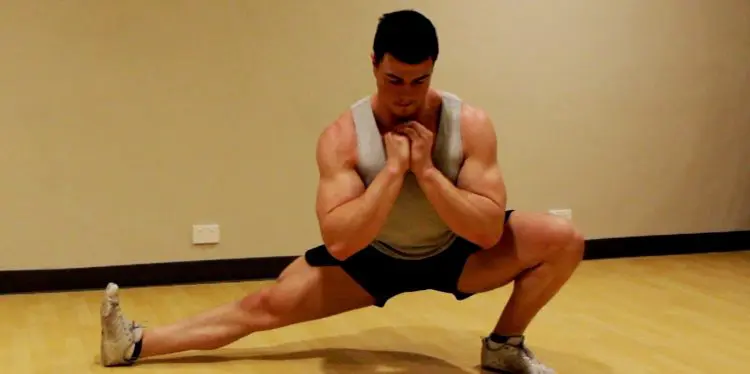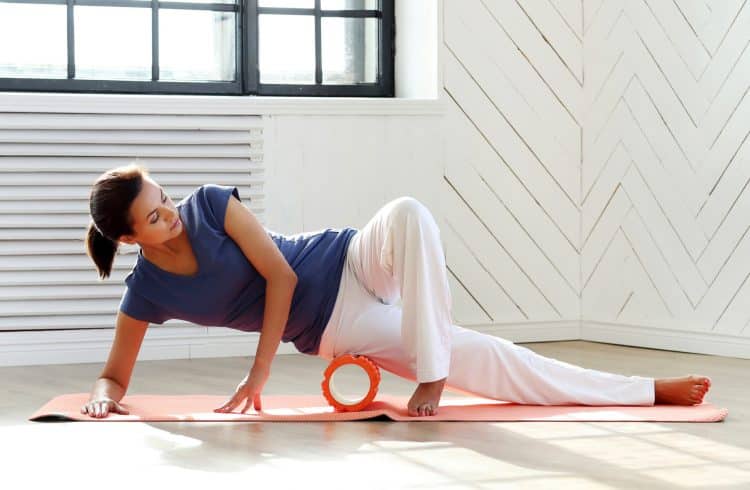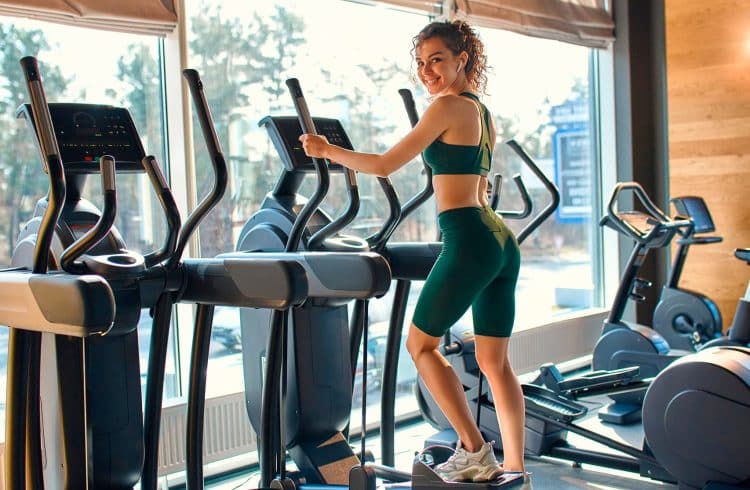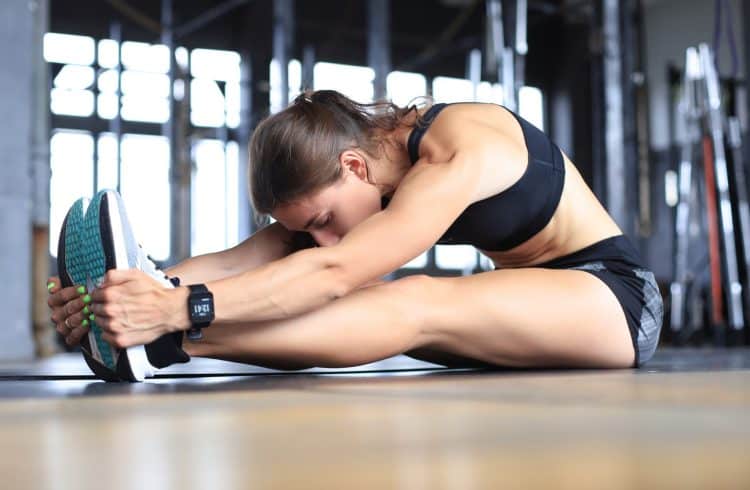After your workout, you may be tempted to collapse in a heap, head off to the showers, and then enjoy a well-earned protein shake. But before doing any of those things, you should also do a cool-down. Unfortunately, many exercisers skip this part of their training session or pay very little attention to it.
With over 35 years of experience as a personal trainer, I’m constantly preaching the benefits of an optimal cool-down routine to promote recovery and progress after the training session and boost performance in the next session.
In this article, I explain why and how to cool down and provide some of the best cool-down exercises to maximize your results.
Recent Updates: On June 10, 2024, Fitness Volt’s Senior Editor, Vidur Saini (American Council on Exercise-CPT), updated the article and added actionable expert tips throughout the piece to improve the reader experience.
How to Cool Down
While an effective warm-up has several phases, a cool-down has only two phases: a pulse lowerer (cardio) and stretching and mobility exercises. As such, your cool-down should only take five to 15 minutes.
The actual length of your cool-down will depend on how hard you just trained. The more intense your workout is, the longer you’ll probably need to cool down. Also, if you trained a lot of different muscles, you’ll need a little longer to return them to their pre-training state.
Level Up Your Fitness: Join our 💪 strong community in Fitness Volt Newsletter. Get daily inspiration, expert-backed workouts, nutrition tips, the latest in strength sports, and the support you need to reach your goals. Subscribe for free!
Please wait…
So, how long should a cool-down be? The simple answer is long enough to get the job done!
3 Cardiovascular Cool Down Exercises (5-10 minutes)
During resistance training, the body diverts blood to the working muscles. This is called blood pooling. Additionally, lactic acid and other waste products accumulate in this area. These metabolites are thought to be one of the causes of muscle soreness.
Post-workout low-intensity steady state (LISS) cardio pumps freshly oxygenated blood around your entire body to eliminate blood pooling, reoxygenate your muscles, and flush out metabolic waste products. It should also gradually lower your heart and breathing rate.
The most efficient cooling-down cardio exercises include:
- Walking: A brisk pace around the gym or even outdoors.
- Slow Cycling: If your gym has stationary bikes, hop on and pedal easy.
- Rowing: Maintain a relaxed pace on the rowing machine.
Start at a moderate level of intensity and then decrease speed and effort over several minutes until your heart and breathing rate are close to their pre-exercise level.
Three to five minutes should be sufficient for most people.
By the end of this phase, your heart and breathing rate should be close to normal, and your muscles may even feel somewhat reenergized after being flushed through with oxygenated blood. However, you must not turn this into a high-intensity interventional training (HIIT) cardio workout, which would somewhat defeat its purpose.
17 Dynamic and Static Stretches (10-15 minutes)
Once your heart and breathing rate is back to normal, you are ready to stretch and mobilize the muscles and joints you have just been training. This phase aims to prevent any adaptive shortening of the muscles, improve muscle elasticity, promote good posture, and reduce muscle soreness.
Flexibility and mobility are similar and codependent but also somewhat different. Flexibility refers to the elasticity and extensibility of your muscles, while mobility is the freedom of movement at your joints.
As such, flexibility involves stretching and holding your muscles in a lengthened position, while mobility involves moving your joints through a wide range of motion. Your post-exercise routine should comprise dynamic and static stretches to optimize your recovery.
10 Static Stretches
The best type of stretches for the cool down are static stretches. These involve easing into a stretch and then holding it for time. If you’ve got good flexibility, you only need to hold a stretch for 20-30 seconds to maintain your current muscle elasticity.
However, if your muscles are tight, you must hold your stretch for longer — typically 60 seconds or more.
You should customize your cool-down stretches based on your flexibility needs and the workout you’ve just done. Spend more time on the muscles that need it. Furthermore, choose stretches that target the muscles you worked during your lifting session. Examples include:
- Hamstring Stretch: While standing, reach for your toes with a straight back.
- Quad Stretch: Standing, grab your foot and gently pull it towards your glutes.
- Calf Stretch: Lean against a wall with one leg extended behind you, heel on the ground.
- Chest Opener: Clasp your hands behind your back and lift your chest.
- Triceps Stretch: Reach one arm overhead and bend your elbow, touching your upper back.
- Supine Hamstring Stretch With Strap: Loop a strap around one foot and gently pull your leg towards your chest while keeping the other leg extended on the ground.
- Doorway Chest Stretch: Stand in a doorway, place your forearms on the doorframe with your elbows bent at 90 degrees, and lean forward.
- Dead-Hang Full-Body Stretch: Hang from a pull-up bar or sturdy overhead structure with your arms fully extended.
- Seated Adductor Stretch: Sit on the ground with your legs spread wide, lean forward from your hips while keeping your back straight, and reach toward your toes.
- Kneeling Forearm Stretch: Kneel on the ground, place your forearms on the ground with your fingers pointing towards your knees, and sit back on your heels.
7 Dynamic Stretches

After statically stretching the muscles that need it most, you should move on to mobilizing your primary joints, namely, your ankles, knees, hips, lower back, and shoulders.
Mobility exercises involve putting the target joint through an extensive but relaxed range of motion. This increases synovial fluid production, which is the body’s own lubricating and nourishing oil.
Level Up Your Fitness: Join our 💪 strong community in Fitness Volt Newsletter. Get daily inspiration, expert-backed workouts, nutrition tips, the latest in strength sports, and the support you need to reach your goals. Subscribe for free!
Please wait…
Focus on the major muscle groups you just trained. Here are a few examples:
- Arm Circles: Forward and backward, gradually increasing the circle size.
- Leg Swings: Front to back and side to side, controlled and fluid motions.
- Torso Twists: Gentle rotations from side to side, keeping your core engaged.
- Walking Lunges: A great way to loosen up your hips and legs.
- Shoulder Rolls: Forward and backward, releasing tension in your upper body.
- Cossack Squat: Stand with feet wide, squat deeply to one side while keeping the other leg straight and foot flat, then repeat on the other side.
- Squat and Hip Pry: Assume a deep squat position, place your elbows against your knees, gently pushing your hips back to open up your hips and groin.
Remember, you don’t need to do all these stretching and mobility exercises. Instead, do the exercises for the muscles you have just trained. So, with that in mind, you may only need 2-3 movements from each list.
Cool Down Exercise Bonus — Foam Rolling

Foam rolling is a deep-tissue massage, also known as self-myofascial release. Instead of having someone press down on your body, you lie on the roller and use your bodyweight to apply pressure to your muscles. By rolling up and down, you simulate massage-type movements, and with a bit of creativity and contortionism, you can use a foam roller on virtually every part of your body.
Like all types of massage, foam rolling helps increase blood flow and relax muscles, and it is an excellent way to treat and prevent a wide range of aches and pains. However, what separates foam rolling from regular massage is how it affects the fascia surrounding your muscles.
Tailoring Your Cool Down to Specific Lifting Workouts
Here is a low-down on how you can modify your cool-down routine based on your resistance training sessions:
- Leg Day: Emphasize hamstring, quad, and glute stretches.
- Back and Biceps: Focus on lat, shoulder, and bicep stretches.
- Chest and Triceps: Prioritize chest opener, triceps, and shoulder stretches.
- Shoulder Day: Include additional rotator cuff stretches and mobility exercises.
What is Fascia?
The fascia is a fibrous sheath that envelops all of the muscles. It helps keep the muscles separate, gives them their shape, and is an integral part of the muscular system.
However, fascia can get “gummed up” and adhere to the muscle it surrounds. This can reduce the range of motion and may also cause pain — often felt as hotspots or pressure points, which are areas of localized tenderness.
If ignored, these hotspots can reduce your range of motion and even lead to injury, so it’s a good idea to keep your fascia moving freely. Foam rolling is also known as a self-myofascial release, which, as the name suggests, results in more freely moving muscles and fascia.
Freeing up your fascia is a simple, if initially painful, process. Rolling the muscles will help move that fascia, eliminating adhesions and hot spots. But, the more severe those adhesions are, the more painful and lengthy the process will be.
The key to successful foam rolling is to start light and gradually increase your weight on the roller over several sessions. It might even take you a few weeks to work up to putting your entire weight on the roller.
Don’t worry; even light foam rolling can be very beneficial.
Here’s a basic foam rolling routine that’s perfect for after training as part of your cool-down. You can also do it on your rest days or anytime your muscles feel like they need a massage.
Why Cool Down, Anyway?
A cool-down is the opposite of a warm-up. Warm-ups are designed to help you ease into your workout, while cool-downs ease you back out.

A cool-down aims to return your body to as close to its pre-workout state as possible, called homeostasis. This includes lowering your heart and breathing rate, reducing muscle tension, mobilizing your joints, returning your muscles to their usual resting length, and removing metabolic waste products from your muscle tissues.
Cooling down may help speed up recovery so you can return to training sooner and reduce unwanted aches and pains, such as stiff joints and post-exercise muscle soreness.
It’s worth noting that very little scientific evidence supports the effects of cooling down after training (1). That’s because your body will adapt to your workout regardless of whether you cool down or not. However, there is plenty of anecdotal evidence supporting the effectiveness of cooling down, so it’s probably still worth doing.
If you are on the fence about cool-downs, don’t dismiss them entirely. Instead, use the information in this article, cool down after every workout for a month, and see how you feel.
If you experience fewer post-exercise aches and pains or feel ready to train again sooner, you know cooling down works. But, if you feel no different after a month, you can just hit the showers and skip your cool down, knowing that you aren’t missing out on any additional benefits.
Wrapping Up
The last thing you probably want to do after an intense workout is more exercise. But by spending a few extra minutes cooling down correctly, you may save yourself from unwanted muscle soreness and even speed up recovery so you can return to the gym sooner.
The good news is that an effective cool-down doesn’t have to take long; five to 15 minutes should be plenty for most people.
The best way to make your cool down as time-efficient as possible is to be prescriptive and focus almost entirely on the muscles you have just trained. For example, you don’t need to do cool-down exercises for your legs after an upper-body workout.
Use the methods and exercises in this article to create the perfect cool-downs for your workouts. Your body will thank you for your time and effort!
Reference:
- PubMed: Do We Need a Cool-Down After Exercise? A Narrative Review of the Psychophysiological Effects and the Effects on Performance, Injuries, and the Long-Term Adaptive Response
منبع: https://fitnessvolt.com/cool-down-exercises/

